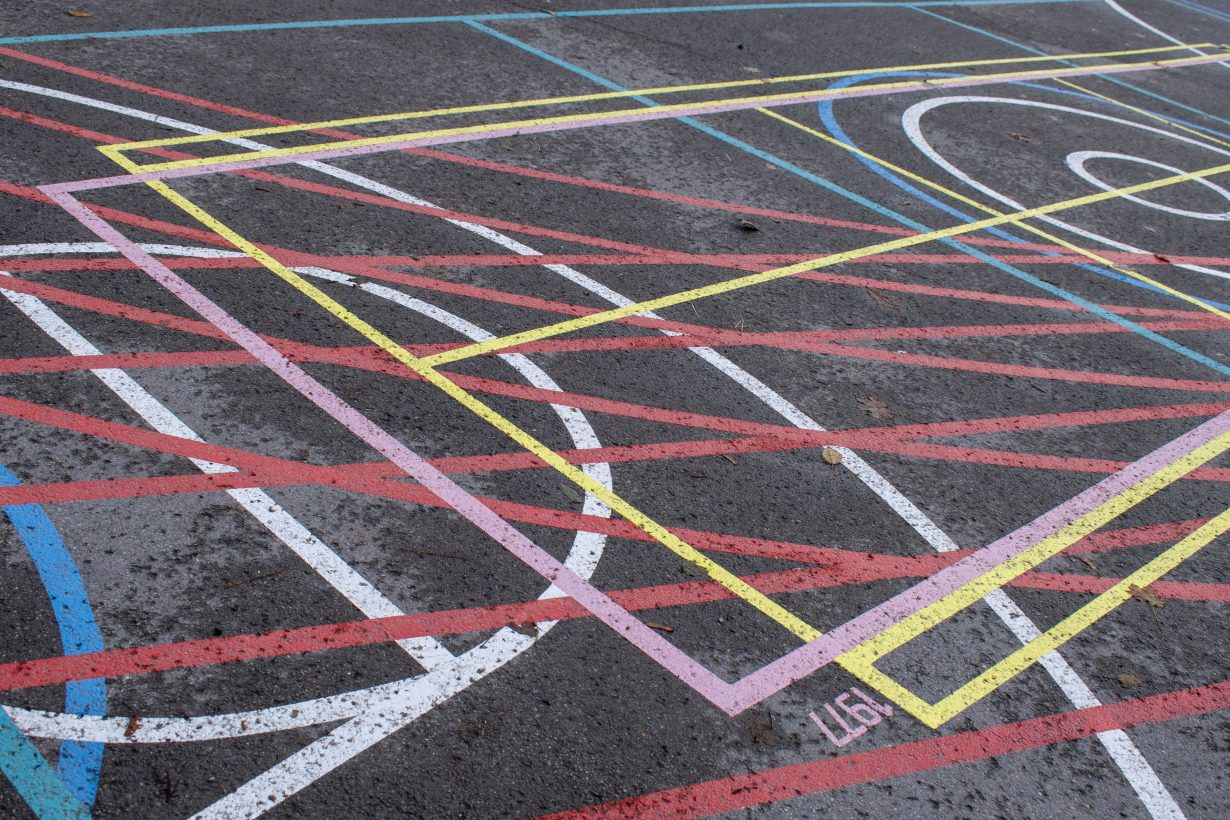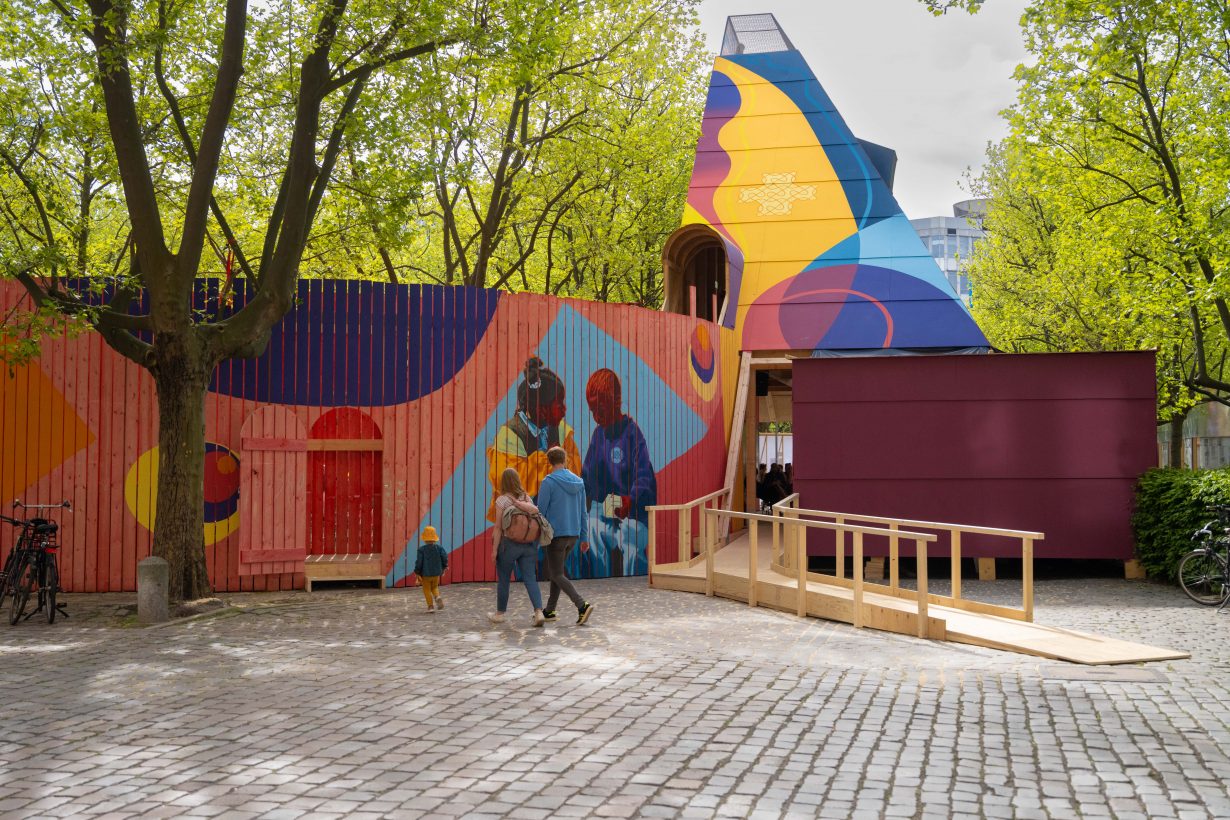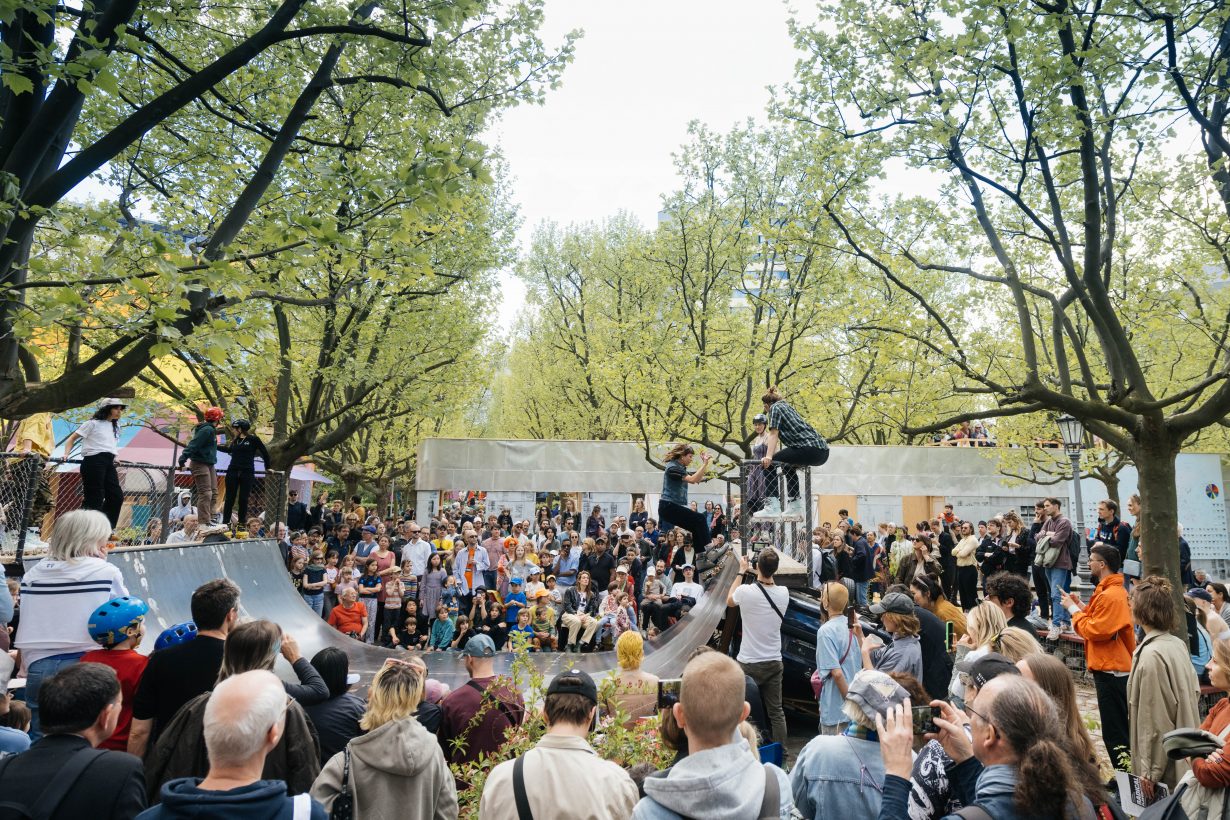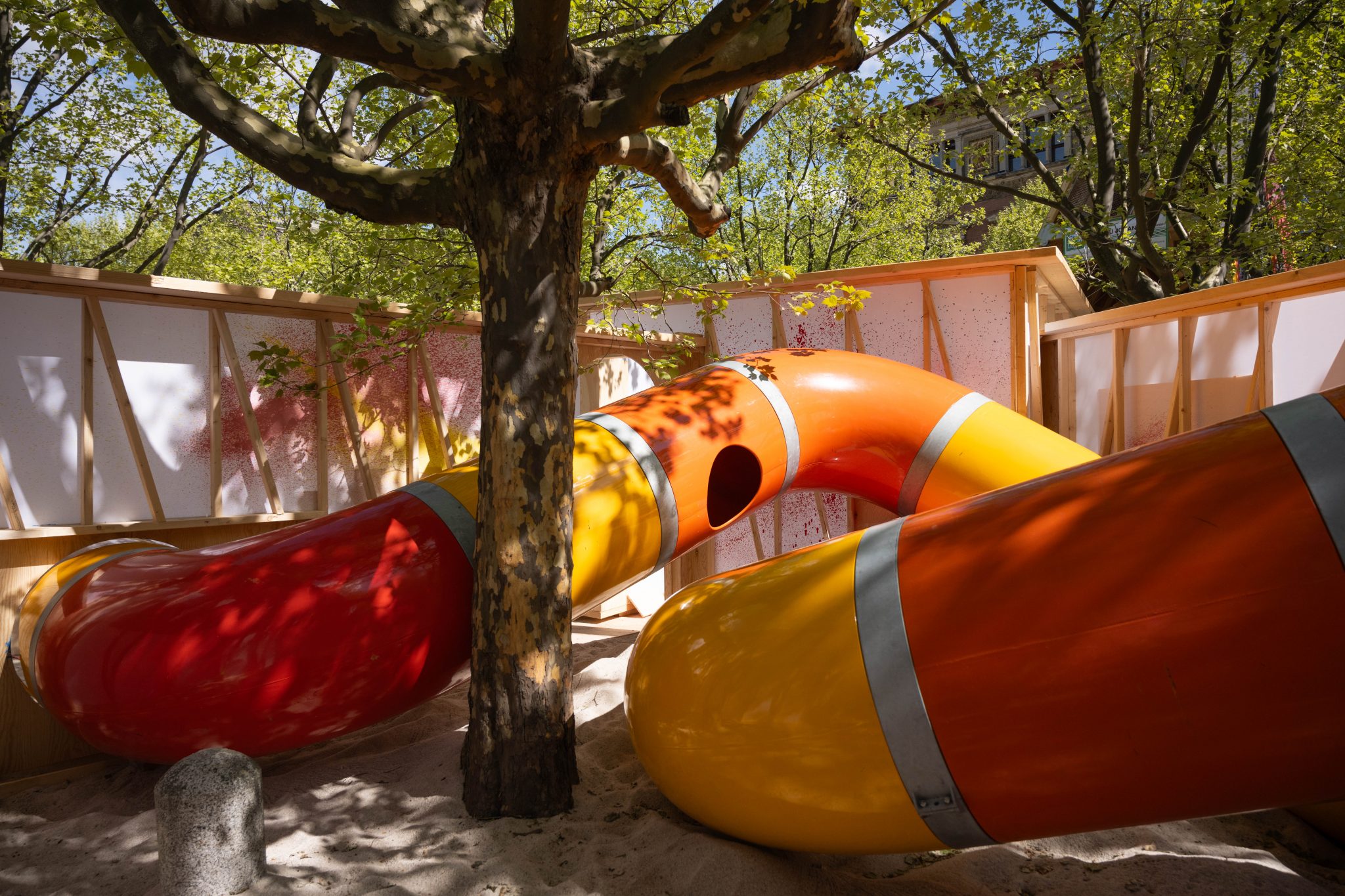While Radical Playgrounds ‘exhibits’ at Gropius Bau in Berlin, artist and writer Nika Dubrovsky spoke with curator Joanna Warsza about the playable exhibition, the division between children and adults, and how play might reshape our relationships
Created to coincide with the UEFA European Football Championship (which, as most of you art-lovers probably won’t have noticed, is taking place in Germany this summer) and taking it’s lead from Lina Bo Bardi’s statement about the relationship between museums and playgrounds – those of you who’ve been paying attention to art fads will be nodding sagely to yourselves round about now, at the notion that the Italian-born Brazilian architect is having something of a moment right now, having also inspired some of the displays at this year’s Venice Biennale and an unrelated earlier exhibition at Singapore’s National Gallery – the group exhibition Radical Playgrounds seeks to challenge received wisdom about creating, visiting and engaging with public space. And, in doing so, perhaps to envision a new, inclusive form of public. ArtReview was dying to know what that’s all about.

Nika Dubrovsky There’s no need to buy tickets for the Radical Playgrounds exhibition: the exhibit is located in the park next to the museum and is free and open to the public. That’s unusual for museum shows these days. How did this project came about?
Joanna Warsza It is an exhibition that went out of the museum, outside the symbolic protection of its walls. It is a cross between a conceptual playground and a sculpture park that attached itself as an extension to Gropius Bau. In Germany there is always a lot of money for football, and so it was the case this year. The project came as an invitation to critically respond to the men’s European Football Championships with a largescale art and architectural intervention. It was a similar to 2006 during the World Cup, when Harald Szeemann, and after his death Dorothea Strauss, organised his last (and very inspiring) exhibition, on football, at the Gropius Bau.
The architectural collective raumlabor and I were invited to come up with an idea. We called our journey ‘from competition to collaboration’ and shifted the focus from the competitive stadium mentality to that of free play, in the form of a critical playground with 16 artist commissions. We use the basic playground vocabulary – be it a swing, a labyrinth or a sandbox – to speak about serious topics such as inclusion and exclusion, the history of playgrounds, the tension between the rules and freedom, activism and play, and digging out the dark past buried underground.
ND I know you are the mother of a young boy, so I’d like to ask how your personal and professional life intersected while you were putting together this exhibition. It seems to me that for many people who visited your exhibition, and certainly for me as a mother who has spent many hours of my life on the playground, your exhibition was a magical blend of personal experience and professional interest.
JW One of the main inspirations behind Radical Playgrounds was my growing boredom at the many various Berlin playgrounds in which I was hanging out with my son in recent years. One day I started hallucinating about all those boats, rockets and slides. I started to nurture a need for playgrounds to be more multidirectional, richer in layers, in possible transgenerational semiotic and cultural readings. What if a wooden pirate ship would also enable an experiment in self-governance or a performance of radical social justice? Could its deck be a reading spot for, say, David Graeber’s posthumous book Pirate Enlightenment, looking at the proto-democratic pirate practices beyond the usual romance and fantasy?
This is how the exhibition came about: a swing is a just swing, you are welcome to use it and you do not need to read any curatorial description to understand it. But here, through the art and activism of Joar Nango, Sámi architect and artist, and his idea of how to reorganise knowledge based on his concept of ‘indigenuity’ (a combination of the words ‘ingenuity’ and ‘indigeneity’), it is also a swing that wants to change the world. Or a playing field by Céline Condorelli called Play for Today. She merged several playing fields: football with a running track, and badminton, pétanque and volleyball courts. Somewhere along them one notices dates: 1920, 1921, 1926, 1952, 1956 and 1977. Those mark the years in which women were allowed to compete in international tournaments in those sports. The history of those who find reasons why others can’t play is as long as games themselves, and it continues.


ND Radical Playgrounds shows us different versions of how humans communicate with each other using objects. The installation about the history of games is an illustrated version of this. But then there is a twist in the story, all the data set of human games were put into the machine learning. Tell us more.
JW Agnieszka Kurant in her installation Quasi-Objects (2024), astudy of games, looks at the concept of collective intelligence, at the fact that games do not have individual authors, inventors or designers. There is no single person who invented football, the boomerang, skipping rope, dominoes, chess or tic-tac-toe. Games evolved in unpredictable ways through the collaboration of people from around the world over millennia, and we can see them as part of the planetary commons. Next to a map sit her playable, hybrid sculptures generated by AI based on a dataset created from the history of games. Through this process, machine learning proposed to us two, new non-existing games, the rules of which are unknown to us. It is like a playable monument to collective intelligence. On the morning of the opening I was afraid that children would ignore them, since they are so alien. Luckily I was wrong. They were taken over within minutes. It seems that it is rather us adults who care about the fixed rules. I believe that play is a political category, which allows us to come together with and despite our differences, something very much needed currently in Germany. When we play we take distance from ourselves, from our egos and sorrows, and then can come back together again.
ND Playgrounds are built as collective spaces, contrary to art exhibitions organised around the names of artists or curators. Tell us how this idea is realised in your project.
JW Our inspiration was a historical exhibition Modellen, which famously transformed Moderna Museet in Stockholm in 1968 into an adventure playground, stating ‘this is an exhibition only for those who do not play’. Initiated by the activist group Aktion Samtal – among them curator and activist Gunilla Lundahl and artist Palle Nielsen – it advocated for children’s right to the city. Despite being a huge success, the museum tried to close it earlier, which raised the question about who the museum was actually for, the general public or the upper bourgeoisie? Many of these questions are still at stake. Radical Playgrounds does use the codes of an exhibition: there is a list of artists who contributed with playable artworks, there are curators, there is a series of the pavilions by raumlabor. But you can touch everything, you can be loud, you can eat and drink, you can receive it with all senses. Seems simple and yet it is not, this is why many people do not dare to cross the doorstep of many museums. They are still very intimidating for many people, while playgrounds are not, they are much more collective and inclusive spaces. You do not need to have a nuclear family to enjoy them. In the morning seniors do yoga, in the afternoon kids play, at night the teenagers have dates. I believe that museums can generally learn a lot from the concept of play and playgrounds on how to mix the high and low, serious and funny, art and life, towards breaking the culturally masculine and intimidating codes they were founded on. Some parts of our exhibition will find a home in the permanent playground now being planned for inside Gropius Bau.


ND Playgrounds are built for children. For my book Cities Made Differently [forthcoming in 2024], I looked at the history of playgrounds in New York and was surprised to learn that they were designed to isolate children’s lives from adults, so parents could work in factories and offices while kids would be supervised by professional adults. Originally, New York City Hall hired ‘specialists’ to oversee ‘proper’ play and prevent children from engaging in inappropriate games. Not surprisingly, early twentieth-century New York City children resisted this supervision as much as they could. You mentioned being a mother spending a lot of time on the playground with your son, wondering what an adult playground would look like. Is this exhibition an attempt at such a project, where children and adults can play together?
JW In the middle of Radical Playgrounds sits an exhibition within the exhibition called The Playground Project, which focuses on 100 years of playground history. What I have realised through this ongoing research by Gabriela Burkhalter, the playground historian, is that as much as play is universal, the playground is a Western invention connected with the industrial revolution. It aimed to create safe spaces for kids when the streets were getting dangerous. The sandpit is the beginning of it all. Playgrounds, unlike the museums which are often there to preserve, are continually updated to the current health and safety standards, so it is almost impossible to see historical play objects, like the Lozziwurm – the legendary sculpture by Yvan Pestalozzi from 1972, which we miraculously got permission to install. We wanted to create an exhibition for many ages and sensibilities at the same time. A multidimensional public space where the differences can be played out, where the big and small have their own way of reading, without necessarily having to play all the time together. So while you, say, watch the images in the exhibition, the kids crawl through the Lozziwurm and then we meet again at the end. Generally, playgrounds have gone through different forms of control, anarchy and social regeneration, from reform movements, adventure playgrounds, junk playgrounds, social projects to the initiatives of today, such as building and rebuilding playgrounds in Gaza, Ukraine and other war zones. In the end the kids are the most affected.
ND One of the most important questions for me is about the essence of competition versus play in which there are no fixed rules, so it is impossible to find out who wins and who loses. How does that relate to the idea of playing and how these ideas developed in your exhibition?
JW One of our main focuses was to look at the difference between the concepts of games and free play. Games have a set of rules and clearly defined winners and losers: they are often about channeling emotions and sublimating conflict and confrontation. While playing with each other, we are free to constantly change the situation and invent the rules as we go along. A flirt, a conversation, a dance, a negotiation or politics is a form of play. The whole performance studies field is also about ‘the games people play’ from rituals, protocols to technological performance. I am generally interested in the format of performative exhibitions. The notion of performative as, on one hand, having a creative and life force, and yet being subversive and potentially destabilizing at the same time. After the experience of Radical Playgrounds I now understand better why Lina Bo Bardi once said: ‘Every museum deserves a playground’.
Radical Playgrounds: From Competition to Collaboration, curated by Joanna Warsza and Benjamin Foerster-Baldenius, at the Gropius Bau, Berlin, through 14 July
